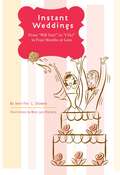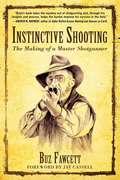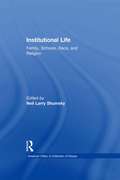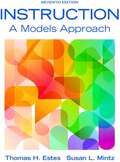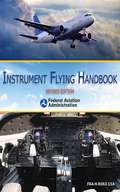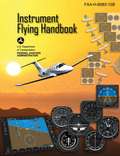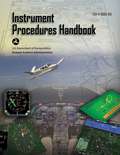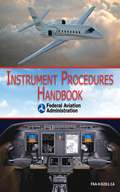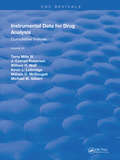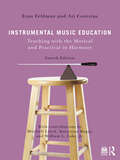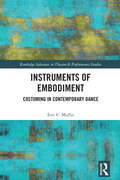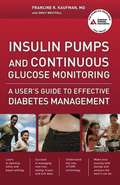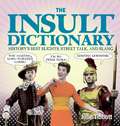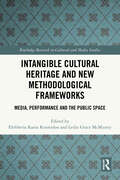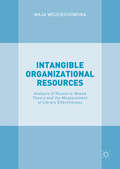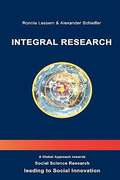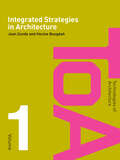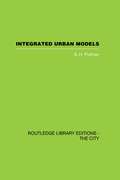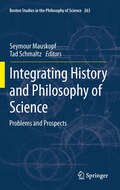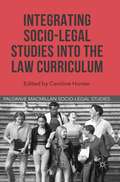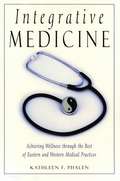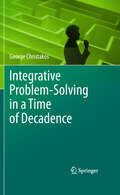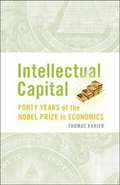- Table View
- List View
Instant Weddings
by Jennifer Shawne Mary Lynn BlassutaHow to pull off a stylish dream wedding when time is of the essence? Answers abound in Instant Weddings, the hip and illustrated handbook for aspiring quicklyweds who want more than a Las Vegas moment. Where most wedding guides emphasize perfection and glamour, Instant Weddings celebrates creativity, ingenuity, and flexibility, proving that you can have your fabulous last-minute cake and eat it too. Handy checklists cut to the chase, condensed timelines keep the couple on the fast track, and practical tips pulled from real-life weddings make for an indispensable resource. For anyone who suspects that a wedding planned in 16 months has nothing on one planned in 16 weeks, Instant Weddings offers instant gratification.
Instinctive Shooting: The Making of a Master Shotgunner
by Buz FawcettLearn to point and shoot like a pro with these easy-to-follow tips.“Here, point and shoot.” These words from his father propelled Buz Fawcett’s shooting success as a child, gaining him a number of High Gun awards at local trap clubs by the time he was fourteen. Instinctive Shooting is Fawcett’s guide for other gunmen, describing exactly how and what needs to be done to achieve the ultimate shooting instincts. Practical and hands-on, the book covers such topics as:Determining your dominant eyeAchieving proper shotgun fitHow to correct point and shootSelecting equipmentPractice regimensCare, cleaning, and maintenanceMuch more!Whether you’re looking to improve your success out in the field or on the sporting course, Buz Fawcett’s time tested advice is an eye-opening look at an approach that can help all shotgunners. Experienced shooters who hunt birds, deer, and big game as well as clays and skeet sportsmen looking for a new approach or just an extra edge should take a look at Instinctive Shooting.
Institutional Life: Family, Schools, Race, and Religion (Essays on Mexico Central South America)
by Neil Larry ShumskyFirst Published in 1996. Volume 8 in the 8-volume series titled American Cities: A Collection of Essays. This series brings together more than 200 scholarly articles pertaining to the history and development of urban life in the United States during the past two centuries. Volume 8 discusses several institutions that are uniquely urban: voluntary associations, vigilance committees, and organized police forces. These articles attempt to consider race and ethnicity class, gender, and the various experiences of different groups of Americans.
Instruction: A Models Approach , Seventh Edition
by Thomas H. Estes Susan L. MintzPre-service, beginning, and experienced teachers alike can turn to this comprehensive resource for help in expanding their instructional repertoires through instructional models presented within a standards-based and instructionally aligned process. The authors present 10 evidence-based instructional models and their variations offering a range of cognitive approaches to instruction creative, compliant, collaborative, competitive, inductive, deductive, concrete, and abstract. Each model is discussed using helpful elementary and secondary examples, a variety of academic content areas, detailed steps for implementation, and a look at the demands on students. The new edition of Instruction: A Models Approach includes several features that support the development of instructional skills: chapters move from concrete models to abstract (simple to more complex) to build a clearer understanding of the ideas, video examples, and instructional strategies illustrate the concepts, and extension activities offer practice with important new information and skills. The result is a classroom-ready resource that makes instructional models clear and relevant for readers within a standards-based and instructionally aligned process. The Enhanced Pearson eText features embedded video and internet resources.
Instrument Flying Handbook: Revised Edition
by Federal Aviation AdministrationThe Federal Aviation Administration’s Instrument Flying Handbook provides pilots, student pilots, aviation instructors, and controllers with the knowledge and skills required to operate an aircraft in instrument meteorological conditions.This up-to-date edition is illustrated with full-color graphics and photographs and covers topics such as basic atmospheric science, the air traffic control system, spatial disorientation and optical illusions, flight support systems, and emergency responses. The book’s two appendixes contain information on clearance shorthand and an instrument training lesson guide. Readers will also find a handy glossary and index.Since many questions on FAA exams are taken directly from the information presented in this text, the Instrument Flying Handbook is a great study guide for potential pilots looking for certification and a perfect gift for any aircraft or aeronautical buff.Additional topics included throughout this text include:Ground-based radar navigationApproaches to civil airportsFlying and landing in difficult weather conditionsAircraft system malfunctionsAirspace classificationDifferential global positioning systemsAnd many more!
Instrument Flying Handbook (Federal Aviation Administration): FAA-H-8083-15B
by Federal Aviation AdministrationThis is the FAA's primary pilot resource for instrument flight rules and training. It (IFR) covers everything pertinent to operating an aircraft, both in instrument meteorological conditions (IMC) and without reference to outside visuals, relying solely on the information gleaned from the cockpit. Information applies to both analog and electronic flight displays, and is organized into separate coverage of the traditional and pictorial displays.Instrument Flying Handbook includes chapters on national airspace system, the air traffic control system, human factors, aerodynamics, flight instruments, flight maneuvers for IFR operations, navigation, emergency operations, as well as helicopter operations and more. Advanced systems are covered, including flight management systems, the primary flight display (PFD) and multi-function display (MFD), synthetic vision, and traffic advisory systems. Instrument clearance shorthand is discussed, and an instrument training lesson guide is provided.The Instrument Flying Handbook is designed for use by flight instructors, pilots preparing for the Instrument Rating FAA Knowledge and Practical Exams, and instrument-rated pilots looking for a refresher or preparing for an Instrument Proficiency Check (IPC). This edition features with full-color illustrations and diagrams, along with a comprehensive glossary and index.
Instrument Procedures Handbook: FAA-H-8083-16A (FAA Handbooks Ser.)
by Federal Aviation AdministrationThis is the new 2015 edition of the FAA's previous "Instrument Procedures Handbook" (previously the FAA-H-8083-16).This book covers all of the information needed to operate safely within the airspace system. In the FAA's "Instrument Procedures Handbook" (#FAA-H-8083-16A) the emphasis is placed on operations and procedural information for real-world use, which makes this the next logical step for pilots after learning basic instrument skills from the FAA's "Instrument Flying Handbook" (#FAA-H-8083-15B). Using this book, pilots can more directly apply the concepts to their current flying situation, and learn how their acquired skills are best used in today’s IFR environment. Considered industry-wide as a top source for instrument procedures information and a "must read” for all instrument pilots, this new 2015 edition brings pilots the latest changes to procedures and even more insights and guidance on how to operate safely within the national airspace system. Detailed information is provided for every navigation receiver and phase of flight on the required precision necessary to stay within protected airspace and to make a successful approach.While it was designed as a reference for professional pilots, the specialized glossary, index, full-color illustrations and photographs in this book make it a valuable training aid for flight instructors, instrument pilots, and instrument students alike. Each topic covered is well-detailed and explained in user-friendly terms, along with full-color depictions to aid understanding.Instrument flight instructors, pilots, and students will need this resource since it is used as a reference for the Airline Transport Pilot and Instrument Knowledge Tests and for the Practical Test Standards. Whether a pilot is a seasoned professional or recently completed an Instrument Rating course, this FAA handbook is sure to encourage more precise instrument techniques and ultimately create a safer pilot.
Instrument Procedures Handbook: Faa-h-8083-16a (FAA Handbooks Ser.)
by Federal Aviation AdministrationDesigned as a technical reference for instrument-rated pilots who want to maximize their skills in an "Instrument Flight Rules” environment, this revised and up-to-date edition of the Federal Aviation Administration’s Instrument Procedures Handbook contains the most current information on FAA regulations, the latest changes to procedures, and guidance on how to operate safely within the National Airspace System in all conditions. Featuring an index, an appendix, a glossary, full-color photos, and illustrations, Instrument Procedures Handbook is the most authoritative book on instrument use anywhere.
Instrumental Data for Drug Analysis, Second Edition: Volume VII (Forensic And Police Science Ser.)
by Terry MillsVolume 7 of this classic collection presents a comprehensive index to the first six volumes, providing quick and easy access to the data in this exhaustive resource, and completing the set.
Instrumental Music Education: Teaching with the Musical and Practical in Harmony
by Evan Feldman Ari ContziusInstrumental Music Education: Teaching with the Theoretical and Practical in Harmony, Fourth Edition, is intended for college instrumental music education majors studying to be band and orchestra directors at the elementary, middle school, and high school levels. Its fundamental goal is to prepare music teachers for the real world, looking at the topics vital to running a successful instrumental music program, while balancing musical, theoretical, and practical approaches. A central theme is the compelling parallel between language and music, including "sound-to-symbol" pedagogies. Understanding this connection improves the teaching of melody, rhythm, composition, and improvisation.Unique to this book is its research-based approach; its overview of a variety of educational sites is more extensive than any similar resource. Its accompanying Instructor and Student Resources include over 120 videos filmed with high school, college, and community concert, pedagogy videos for all wind and string instruments, presented by professional players and teachers.New to this edition: A section on social emotional learning (SEL) An introduction to culturally responsive teaching Additional discussion of teaching composition, improvisation, and creativity Expanded discussion of the advantages, challenges, and philosophies surrounding teaching ensembles other than band and orchestra Many updates and additions throughout the text Offering best practices rooted in experience and clear, balanced coverage of pedagogical, philosophical, and administrative issues, this textbook effectively prepares future band and orchestra instructors to teach at all levels.
Instruments of Embodiment: Costuming in Contemporary Dance (Routledge Advances in Theatre & Performance Studies)
by Eric MullisInstruments of Embodiment draws on fashion theory and the philosophy of embodiment to investigate costuming in contemporary dance. It weaves together philosophical theory and artistic practice by closely analyzing acclaimed works by contemporary choreographers, considering interviews with costume designers, and engaging in practice-as-research. Topics discussed include the historical evolution of contemporary dance costuming, Merce Cunningham’s innovative collaborations with Robert Rauschenberg, and costumes used in Ohad Naharin’s Virus (2001) and in a ground-breaking Butoh solo by Tatsumi Hijikata. The relationship between dance costuming and high fashion, wearable computing, and the role costume plays in dance reconstruction are also discussed and, along the way, an anarchist materialism is articulated which takes an egalitarian view of artistic collaboration and holds that experimental costume designs facilitate new forms of embodied experience and ways of seeing the body. This study will be of great interest to students and scholars working in performance philosophy, philosophy of embodiment, dance and performance studies, and fashion theory.
Insulin Pumps and Continuous Glucose Monitoring
by Francine R. KaufmanA diabetes diagnosis no longer means giving up an active life. New technology, such as insulin pumps and continuous glucose monitors, can help people with both type 1 and type 2 diabetes stay active and flexible and maintain healthy attitudes and lifestyles. Insulin Pumps and Continuous Glucose Monitoring explains how this new technology can dramatically improve care, as well as how to prepare for the physical and psychological challenges that come with these new regimens. It provides a comprehensive medical approach to diabetes management and pump therapy with an appreciation for the real-life challenges and frustrations faced every day by people with diabetes. By offering greater flexibility and control, insulin pumps and continuous glucose monitors are revolutionizing glucose management for people on insulin therapy. Dr. Kaufman's book shows how people with diabetes can use this technology to improve not only their diabetes care, but their lives as well.
The Insult Dictionary
by Julie TibbottDo you long for the days when a jerk was a "cad"? Want to tell that "swillbelly" to clean up his table manners and that grumbling "glump" to stop whining? Would you like a way of saying simpleton that's not quite so simple--"ninnyhammer," perhaps?All this nastiness and more can be found in the pages of this fun reference book. With insults ranging from Roman times (lutum lenonium = filthy pimp) and Shakespearean snipes (I'm talking to you, you knotty-pated fool) to salty pirate-speak and Wild West zingers, you're sure to find an insult for everyone, be they a helminth (a parasite in Ancient Greece) or a swinge-buckler (an Elizabethan braggart).Chapters are organized chronologically by historical period--Ancient Attacks, Medieval Madness, Edgy Elizabethans, Victorian Venom, Jazz Age Jibes, and Cold War Cuts--and include themed sidebars focusing on Pirate Put-Downs, Hobo Huffs, and Cowboy Curses, as well as samplers for words with many different sayings per period. Fun, a little bit lewd, and incredibly informative this is a must-read for humor fans, history buffs, armchair etymologists, and the most sneaping of breedbates.
Intangible Cultural Heritage and New Methodological Frameworks: Media, Performance and the Public Space (Routledge Research in Cultural and Media Studies)
by Eleftheria Rania Kosmidou Leslie Grace McMurtryThis book examines media, performance, and the public space as sites of intangible cultural heritage – a heritage that moves beyond physical museums and monuments to encompass film and media, performing arts, oral traditions, social practices, rituals, artifacts, and cultural spaces.Focusing on the current methodological challenges and new frameworks that surround the study of intangible cultural heritage in the public space, this volume explores the ways in which intangible cultural heritage is formed, represented, appropriated, and changed. The authors propose a broad understanding of cultural heritage emerging from the public sphere, encompassing museums, oral traditions, performing arts, social practices, artifacts, media and cultural spaces as the inclusive, collective cultural expressions of everyday culture.This unique and interdisciplinary volume will interest scholars and students of cultural studies, cultural heritage, media and film studies, performance studies, history, and sociology.
Intangible Organizational Resources
by Maja WojciechowskaThis book addressesthe challenges of organizing modern-day institutions, focusing on themanagement of intangible organizational resources of libraries through bothlibrary science and management theory. Highlighting new informationrequirements, knowledge transfer technologies and changing patterns of social behaviour,Intangible Organizational Resources exploreshow these changes are affecting the organization of information services suchas libraries, and discusses what they mean for the effectiveness and quality oftheir services. Making a unique contribution in an otherwise under-exploredfield, this is an essential text for those involved in the organization ofinformation services.
Integral Research: A Global Approach towards Social Science Research leading to Social Innovation
by Ronnie Lessem Alexander SchiefferThe author argues that essential humanism in the social sciences research domain have been super-ceded by rationalism and pragmatism and this does not contribute towards the burning social issues of our time.
Integrated Strategies in Architecture (Technologies of Architecture)
by Joan Zunde Hocine BougdahThis key text presents students with a holistic view of the building design process, bridging the gap between the theory and practice of constructing and assembling buildings. Integrated Strategies in Architecture encourages and enables students to gain a sound understanding of the purpose of buildings, the specialisms that contribute and the available technology. Zunde and Bougdah thoroughly introduce and expose the concepts and technologies that underlie the design process, setting current design in context as part of an evolutionary process, exemplified through historic and contemporary models, and emphasizing the importance of applying a broad variety of technologies in the creation of successful buildings. Topics covered include: space planning, colour theory, communication, management, aesthetics, structures and environmental control. This essential text will greatly assist students of architecture and its technology, construction management and building surveying as well as practitioners as they strive to build better buildings.
Integrated Urban Models Volume 1 (RLE: The City): New Research And Applications Of Optimization And Dynamics
by S. H. PutmanThis book was first published in 1983.
Integrating History and Philosophy of Science
by Seymour Mauskopf Tad SchmaltzThough the publication of Kuhn's Structure of Scientific Revolutions seemed to herald the advent of a unified study of the history and philosophy of science, it is a hard fact that history of science and philosophy of science have increasingly grown apart. Recently, however, there has been a series of workshops on both sides of the Atlantic (called '&HPS') intended to bring historians and philosophers of science together to discuss new integrative approaches. This is therefore an especially appropriate time to explore the problems with and prospects for integrating history and philosophy of science. The original essays in this volume, all from specialists in the history of science or philosophy of science, offer such an exploration from a wide variety of perspectives. The volume combines general reflections on the current state of history and philosophy of science with studies of the relation between the two disciplines in specific historical and scientific cases.
Integrating Socio-Legal Studies into the Law Curriculum (Palgrave Socio-Legal Studies)
by Caroline Hunter David CowanAn important collection examining how socio-legal studies and empirical legal research can be integrated into the law curriculum, looking at both core qualifying subjects and stand-alone socio-legal modules, and considering theoretical and methodological approaches combined with practical examples.
Integrating Technology in Literacy Instruction: Models and Frameworks for All Learners
by Jodi Pilgrim Sheri Vasinda Peggy S. LisenbeeIn the second edition, this text has been updated to address changing literacies surrounding students and the continued importance of effective communication using technology tools in K-12 classrooms. Technology has the power and potential to transform teaching and learning in classrooms and to promote active learning, interaction, and engagement through readily available tools and applications. While both technologies and research in literacy education rapidly evolve, this book presents lasting frameworks for teachers to effectively evaluate and implement digital tools to enhance classroom literacies and learning. Through the lens of Universal Design for Learning (UDL), this text equips educators to develop inclusive learning environments that support the needs and desires of all literacy learners through the integration of technology and literacy instruction. This text presents a range of current models and frameworks, including SAMR, RAT, PICRAT, T3, TPACK, TIPC, and EMSCI. The new edition of this book has been updated to include: Alignment with ISTE standards in each chapter Updates from the 2024 UDL Guidelines 3.0 Updates from the most recent 2024 National Educational Technology Plan Updated technology applications, including AI and its impact Tools for teaching through remote and distance learning Each chapter includes prompts for reflection and discussion to encourage readers to consider ways literacy and technology can enable teachers to become agents of change. This book will be especially beneficial for pre-service undergraduate and graduate teacher candidates, as well as ISTE certified educators and those seeking certification.
The Integration of the European Economy Since 1815
by Sidney PollardSidney Pollard has provided a concise survey of economic issues for students of the European community. Going back to 1815, he links the progress of industrialisation in Europe to the relative ease with which ideas, men and capital were able to cross national frontiers. European frontiers make little economic sense and frequently cut across vital natural links. Professor Pollard shows how open frontiers speeded progress, in the particular circumstances of the spread of industrialisation from Britain to Western Europe and then to the rest of the continent, adn opened up new markets and opportunities of learning and technology transfer. Closed frontiers and the national selfishness of economic warfare led in contrast to stagnation, hostility and at times to all-out war. This classic study was first published in 1981.
Integrative Medicine
by Kathleen F. PhalenKathleen Phelan brings her skills as an investigative reporter and her experience as a medical writer to bear in a tour de force-part history. part story. part resource- for any reader seriously interested in his or her own well-being and in the future of medicine and medical treatment in this country Once considered "alternative; Eastern medicine has gained widespread acceptance by the general public, but it is the blending (or integration) of Eastern healing with Western medicine that is now commanding the attention of the medical community.Dating the birth of integrative medicine to 1971, when James Reston brought the concept of acupuncture and Chinese herbs to America's shores, Phelan traces a movement that's grown into a $15 billion dollar industry in a generation .Through interviews with Eastern and Western practitioners and their clients, she puts a human face on the "crisis" of medical care in our time . Withextensive detail, she recounts the history of both Eastern and Western medicine, presenting the best-and sometimes exposing the myths-of both ancient cures and current high-tech methods.
Integrative Problem-Solving in a Time of Decadence
by George ChristakosPresents a unique study of Integrative Problem-Solving (IPS). The consideration of 'Decadence' is essential in the scientific study of environmental and other problems and their rigorous solution, because the broad context within which the problems emerge can affect their solution. Stochastic reasoning underlines the conceptual and methodological framework of IPS, and its formulation has a mathematical life of its own that accounts for the multidisciplinarity of real world problems, the multisourced uncertainties characterizing their solution, and the different thinking modes of the people involved. Only by interpolating between the full range of disciplines (including stochastic mathematics, physical science, neuropsychology, philosophy, and sociology) and the associated thinking modes can scientists arrive at a satisfactory account of problem-solving, and be able to distinguish between a technically complete problem-solution, and a solution that has social impact.
Intellectual Capital
by Thomas KarierThere is arguably no award more recognized in the academic and professional worlds than the Nobel Prize. The public pays attention to the prizes in the fields of economics, literature, and peace because their recipients are identified with particular ideas, concepts, or actions that often resonate with or sometimes surprise a global audience. The Nobel Prize in Economic Science established by the Bank of Sweden in 1969 has been granted to 64 individuals. Thomas Karier explores the core ideas of the economic theorists whose work led to their being awarded the Nobel in its first 40 years. He also discusses the assumptions and values that underlie their economic theories, revealing different and controversial features of the content and methods of the discipline. The Nobelists include Keynesians, monetarists, financial economists, behaviorists, historians, statisticians, mathematicians, game theorists, and other innovators. Rich in biographical details, illuminating the modern history of the discipline as a whole, Intellectual Capital allows an audience of lay and professional readers to readily understand the notions that define modern economic science and practice. It pointedly asks, and answers, whether the prizes have been awarded to those economists "who have during the previous year rendered the greatest service to mankind."
